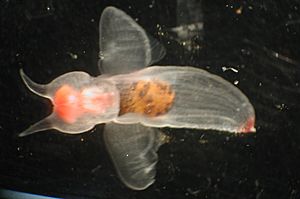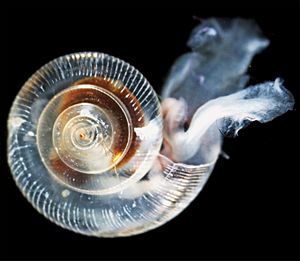Pteropoda facts for kids
Quick facts for kids Pteropoda |
|
|---|---|
 |
|
| A sea angel of the species Clione limacina | |
| Scientific classification |
|
| Kingdom: | Animalia |
| Phylum: | Mollusca |
| Class: | Gastropoda |
| Subclass: | Heterobranchia |
| Informal group: | Opisthobranchia |
| Informal group: | Pteropoda Cuvier (1804) |
Pteropods are special kinds of tiny, free-swimming sea snails and sea slugs. Their name, "pteropod," comes from Greek words meaning "wing-foot." This is because they swim using two wing-like flaps that stick out from their bodies. Most pteropods live in the top 10 meters (about 33 feet) of the ocean. They are usually less than 1 centimeter (about 0.4 inches) long.
Pteropods are divided into two main groups: Thecosomata, known as "sea butterflies," and Gymnosomata, called "sea angels." Sea butterflies have a shell, while sea angels do not. Scientists believe these two groups are closely related, even though they look a bit different.
Contents
Discovering Pteropods
The group of animals called Pteropoda was first named by a scientist named Georges Cuvier in 1804. Other scientists, like François Péron and Charles Alexandre Lesueur, thought this group was even bigger. They included other sea creatures in it.
In 1810, these scientists decided to split the whole group into two parts. One part had animals with a shell, and the other had animals without a shell.
Naming the Groups
In 1824, H.M.D. de Blainville gave names to these two groups. He called the shelled group Thecosomata and the shell-less group Gymnosomata. He also suggested a different name for the whole order, Aporobranchia, instead of Pteropoda.
Over time, many different scientists tried to classify pteropods in their own ways. Some tried to divide them based on whether they had a clear head. Others even tried to make sure each group had a certain number of families and genera.
Eventually, most of these different ideas were stopped. As more and more species of pteropods were found, scientists generally agreed on the classification. They decided to stick with dividing pteropods into Thecosomata and Gymnosomata. It is now thought that these two groups are very closely related.
Threats to Pteropods
How Ocean Acidification Harms Pteropods

Pteropods are very sensitive to changes in ocean water. One big threat they face is ocean acidification. This happens when the ocean absorbs too much carbon dioxide from the air. This makes the ocean water more acidic.
A study was done on the West Coast of the United States to see how ocean acidification affects pteropods. Scientists used a species called Limacina helicina for this test. This type of pteropod has a shell made of calcium carbonate. This material can dissolve in acidic water.
Scientists put a pteropod shell into ocean water that had the same pH level (how acidic or basic water is) that the ocean is expected to reach by the year 2100. After just a month and a half, the pteropod's shell had almost completely dissolved. This shows how vulnerable pteropods are to ocean acidification.
Where Pteropods Live
Pteropods can be found in all the world's major oceans. They usually live in the top 0 to 10 meters (0 to 33 feet) below the ocean surface. They are found at all different latitudes, from the equator to the poles.
While most live near the surface, some pteropods can be found deeper. However, there are fewer of them deeper down. Pteropods from warmer, tropical areas are more common in deeper waters. Very few pteropods live deeper than 500 meters (about 1,640 feet) below sea level.
Pteropods are often found in areas near continental shelves. These places usually have lots of nutrients, which helps them grow and thrive. Springtime is a busy season for pteropods, as their populations grow larger then. However, in areas south of the equator, their numbers do not change as much with the seasons.
Current information suggests that most pteropods in the world, about 93%, belong to the Thecosomata family (the shelled sea butterflies). The remaining 7% are Gymnosomata (the shell-less sea angels).
See also
 In Spanish: Pteropoda para niños
In Spanish: Pteropoda para niños

